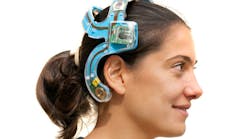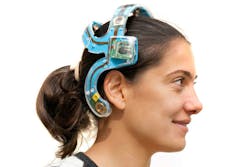There’s nothing new about electroencephalography (EEG), which tracks the voltage changes happening in the brain’s neuron network. Typically, extremely complex nets with numerous sensors are placed on the subject’s head to record these changes through the scalp.
Now, Imec and Panasonic have developed a more elegant solution. Patients may look like they have been assimilated by Star Trek’s much feared Borg Collective, but aesthetically this latest headset looks a lot less scary than some of its predecessors (see the figure).
The Imec/Panasonic wireless EEG system employs ultra-low-power electronics. Its continuous impedance monitoring and use of active electrodes increases the quality of the EEG signal recorded.
Better Performance
The Imec and Panasonic wireless EEG system prototype employs ultra-low-power electronics. Its developers say its continuous impedance monitoring and the use of active electrodes increases the quality of EEG signal recording compared to former versions.
Real-time data is sent to a receiver that can be positioned up to 10 metres away from the person being monitored. Imec and Panasonic believe this latest development is a positive step toward reliable high-quality wearable EEG monitoring systems.
A core element of the design is the low-power (750 µW), eight-channel EEG monitoring chipset. Each EEG channel consists of two active electrodes and a low-power analog signal processor. The EEG channels can extract signals even where considerable common-mode interference exists.
The active electrode chips have a buffer functionality with high input impedance (1.4 GΩ at 10 Hz), enabling recordings from dry electrodes and low output impedance, reducing power-line interference without using shielded wires. This technology is integrated into the headset with dry electrodes, reducing system setup time. And measuring just 35 by 30 by 5 mm, excluding the battery, the system can be easily integrated into other technology.
The system’s circuit-level components include Imec’s active electrodes and EEG amplifier together with a microcontroller and a low-power radio. It can continuously record eight-channel EEG signals while concurrently recording electrode-tissue contact impedance (ETI). This simultaneous ETI recording enables continuous, remote assessment of electrode contact status during EEG recording.
The active electrodes reduce the system’s susceptibility to power-line interference and cable motion artifacts, improving signal quality. The system can be configured to change the settings of the recordings such as the number of channels or enable/disable the impedance recording. The autonomy of the system ranges from 22 hours (eight channels of EEG with ETI) to 70 hours (one channel of EEG only).
The headset has a high common-mode rejection ratio (>92 dB), low noise (<6 µV p-p, 0.5 to 100 Hz), and dc offset tolerance of ±900 mV, and it is ac coupled with configurable cutoff frequency. Sensitivity and dynamic range are configurable through a programmable gain stage. The system can be validated using a commercially available wired reference system (with wet electrodes and skin preparation), comparing the spectra between 1 and 30 Hz.
In Practice
In clinical applications, EEG refers to the recording of the brain's electrical activity over a 20- to 40-minute period. Diagnosis of the recorded data concentrates on the spectral content of the readings.
Primarily, EEG is used to diagnose epilepsy because epileptic activity can create clear abnormalities on a standard EEG study. It also is used to diagnose coma, encephalopathy, and brain death. Furthermore, it’s used to study sleep and sleep disorders where readings are typically recorded for one full night.
EEG used to be a preferred method to diagnose tumors, stroke, and other brain disorders. The high spatial resolution of scanning systems like magnetic resonance imaging (MRI) and computerised tomography, though, have taken its place. Yet EEG does have advantages over those scanning technologies.
The technology continues to be a valuable tool for research and diagnosis when millisecond-range temporal resolution is required and the hardware costs are significantly lower. It also is fairly tolerant of subject movement, which scanning methods cannot tolerate.
EEG doesn’t panic patients that are prone to claustrophobia either. And most importantly, it doesn’t subject people to high-intensity magnetic fields like MRI and magnetic resonance spectroscopy techniques that cannot be used with people who have metal components in them.

